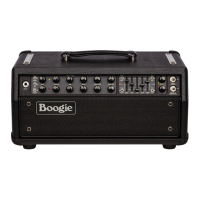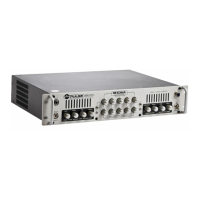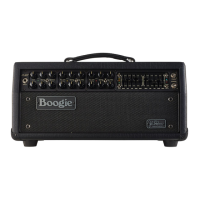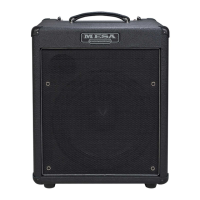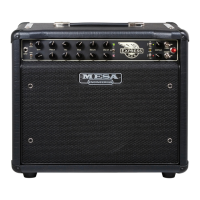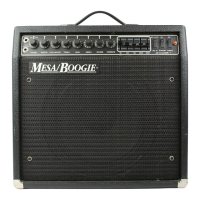PAGE 15
This may be the best sound of all from CRUNCH and certainly one of the sounds that helped its predecessor,
the MARK FIVE, stay a strong and vibrant part of our lineup for well over a decade. From there, gain increases
again, and near the top of CRUNCH’s range, you have a pretty saturated yet still supremely expressive Lead
and/or Heavy Rhythm sound.
Truly one of the MARK SEVEN’s most useful Modes, CRUNCH delivers classic sounds in a wide gain range and
is sure to become a favorite for all kinds of dierent guitars and applications.
CHANNEL 2
Channel 2 begins as a Clean, traditional-gain amp in the duplicated (from Channel 1) FAT Mode and, through
Mode selection, ends up a Beast capable of ripping, searing Brit-influenced high gain performance in the MARK
VII Mode. Along the way, a duplicate CRUNCH (also from Channel 1) fills in the gap as the halfway point with
its wide range of gain that stretches seamlessly between the two extremes.
FAT & CRUNCH
NOTE: Please see the descriptions of FAT and CRUNCH earlier in Channel 1’s “biography” if you need a refresher as to their
gain profile, characteristics, and most appropriate applications.
This third Mode in Channel 2 makes an appearance for the first time on a Boogie here in the MARK VII. We
toyed with the idea of calling it MARK SIX in tribute because there actually was a MARK SIX …in prototype
form. However, it never reached production status, and that was purposeful. Why? Because it was our prov-
ing ground for the subsequent MARK amp to the MARK FIVE, and after years of relentless refinement on that
beloved prototype, we felt we had arrived at a MARK model so good… we had to skip one!
All those miles travelled with the MARK SIX prototype created a fondness for it, so though we haven’t paid the
full tribute due on the Front Panel, we wanted to pay tribute here by mentioning the fact that there was a MARK
SIX… and it was our beloved prototype “mule” that carried us all the way here to the MARK VII and its incredible
sounds and performance. So, if you happen to see a MARK VI for sale on the Internet or elsewhere, beware…it
is counterfeit. We have the one and only MARK SIX preserved in our museum for posterity, so bidding on one
would be akin to someone oering to sell you a bridge.
MARK VII
The new MARK VII Mode, as you may have guessed, appears for the first time on a MARK amp here and like
the two that finish o Channel 3, it’s another incredible high gain Mode. This works extremely well in the overall
scheme of the VII’s footswitching array, and especially being housed alongside the duplicate CRUNCH Mode
in Channel 2. This way, one can use it as either a HEAVY Rhythm sound in Channel 2 and dedicate Channel 3
to any one of the 3 gain Modes there that are great for soloing. Or you could do the opposite and use MARK
VII for a quasi-Brit-influenced Lead sound and dedicate the IIC+ or MARK IV Modes in Channel 3 – most likely
with the Graphic EQ engaged and set to some sort of “V” setting – to your higher gain Rhythm work.
Alternatively… the traditionalist who needs mostly cleaner, lower gain Rhythm sounds can dedicate both Chan-
nels 2 and 3 to dierently voiced Solo sounds of similar (or even wildly diering gain if in Channel 2’s FAT
Mode) but still higher - gain ranges.
And finally, the player who rarely uses Clean sounds might dedicate Channel 1 to CRUNCH for overdriven
Rhythm, Channel 2 to CRUNCH or MARK VII for either Heavy Rhythm or Soloing, and Channel 3 to either of
these applications and others with the IIC+ or MARK IV Modes.
From about 10:00 to 11:30 on the GAIN control, some classic sounds reside in the Brit-style flavor, though albeit
a little more refined and smoother. From there on up to about 2:00, the texture thickens as you gain up. That’s
not to say that the sound becomes too saturated or slow, it doesn’t, it’s just that as the character becomes more
saturated, there will be increased lows and low mids along with the gain introduced on the top end, which
makes the sound wider and fuller.
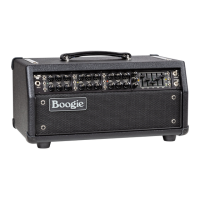
